
Accurate construction forecasting remains a challenge as construction and engineering costs continue to rise, ENR reports. What’s worse, poor cost estimation is among the common problems leading to overruns in construction, and downtime an expensive norm.
Labor, materials, and overhead represent the biggest expenses for the duration of a construction project:
- Labor in the construction industry has been notoriously challenging to calculate. As Carnegie Mellon University illustrates, explains “There are many crafts in the construction labor forces, but most contractors hire from only a few of these crafts to satisfy their specialized needs.” Skilled trades are in demand with 88% of contractors reporting difficulty finding skilled workers and 35% turning down work due to skilled labor shortages.
- Materials management has been shown to have a 6% reduction in craft labor costs due to improved availability of materials as needed on site, and an 8% savings due to reduced delay for materials.
While there are several tools available to manage labor and materials, overhead can be the wild card that can vary project over project and quickly inflate if not managed properly – directly impacting your ability to be profitable. Tools and equipment used on the job fall into this bucket.
A growing trend we see among large construction companies and contractors is job costing. However, job costing is a principle that businesses of all sizes can implement.
Proper Job Costing around tools and equipment allows you to allocate what would otherwise be considered overhead in your tool and equipment investments, so that you are not leaving money on the table for your projects. Simply, you designate rates for tools and equipment, manage how they move from job to job, and have a record of this information. It's also worth noting that union contractors will typically use industry standard rates (NECA, MCAA, etc.).
Depending on the contract type, you may have different goals out of staying on top of tool and equipment costs.
Depending on the contract type, you may have different goals out of staying on top of tool and equipment costs.
Jump Ahead:
What Is Job Costing in Construction and What Is the Purpose of Practice?
No matter the industry, job costing is an important process, and describes the proactive steps taken to track the associated costs and revenue of a given project throughout its lifecycle.

There are a lot of moving parts at play in the realm of construction company, particularly when projects are inflight. Construction job costing helps stay on top of associated costs (labor, materials, overhead) to, at any given time, give stakeholders a complete picture of a project cost breakdown.
In construction job costing, companies or individuals (e.g., contractors, business owners, and tradespeople) can implement detailed pricing methods when charging customers or building partners upfront to ensure they can accurately bid for projects with more faithful cost projections.
While these methods are often used by large companies undertaking megaprojects, construction job costing helps contractors and construction businesses of all sizes improve their budgeting monitoring, manage their cash flow and optimize profit margins, and potentially evade expensive rework.
Job Costing vs Process Costing: Is There a Difference?
As Oracle notes, job costing, while related to, is separate from a similar term, process costing. Process costing is a practice used in accounting where companies assign costs to a range of products or outputs generated from projects.

As they note, process costing “breaks down costs over a given timeframe, […] useful when the cost of individual units can’t be easily differentiated,” while job costing “is a means of quantifying all of the individual costs required to deliver a unique project output like a small-scale manufacturing run.”
Consider the graph Oracle lays out below to get a better picture of this distinction (we’ve edited it to reflect construction applications), job costing vs process costing:
| |
Job Costing |
Process Costing |
| Purpose |
Calculating costs of individual jobs or projects, useful to construction. |
Calculating costs of projects that deliver many units of the same output, useful in manufacturing, prefabrication, etc. |
| How It's Calculated |
Total costs = Total labor + material + overhead. |
Total costs = Per unit cost of labor, material, and output, which represents the total cost of delivering many units over a set timeframe. |
| How It's Used |
Projects using multiple workstreams with different outputs and stakeholders—precisely why digitization and data hubs are so important. |
Projects that consistently deliver the same products at scale, when there is an opportunity for continuous streamline, such as manufacturing. |
As Oracle notes, construction companies rely on job costing to stay on budget and remaining profitable, while balancing “complex projects that involve enormous volume and range of materials, as well as parentships with multiple subcontractors.” Furthermore, tool rooms—managing the transportation and logistics of getting tools and equipment to the job on time—play an important role in keeping construction companies preventing downtime in construction projects, as we’ve discussed before. Thus, construction inventory managers could equally benefit from job costing. “Logistic networks are complex and require a rigorous, accurate process to accurately cost operations,” notes Oracle. “[J]ob costing allows [construction inventory managers] to factor in the nuances of their operations to help shape their pricing and contractual terms.”
To reiterate: Job costing is useful to construction companies and contractors, who work on project-by-project bases, often with several key colliding stakeholders—clients, architects, project managers and the C suite, inspectors, etc. Put another way, while process costing may be synonymous with lean manufacturing, job costing should be synonymous with lean construction.
Benefits of Job Costing: Why Is Job Costing Important in Construction?
Whether you’re a Lean Construction pro or aspire to start adopting certain Lean methodologies, Job Costing is something that plays a critical part of making sure your business is running as efficiently as possible by ensuring the assets you have can be tied to the generation of value instead of just the cost of doing business:
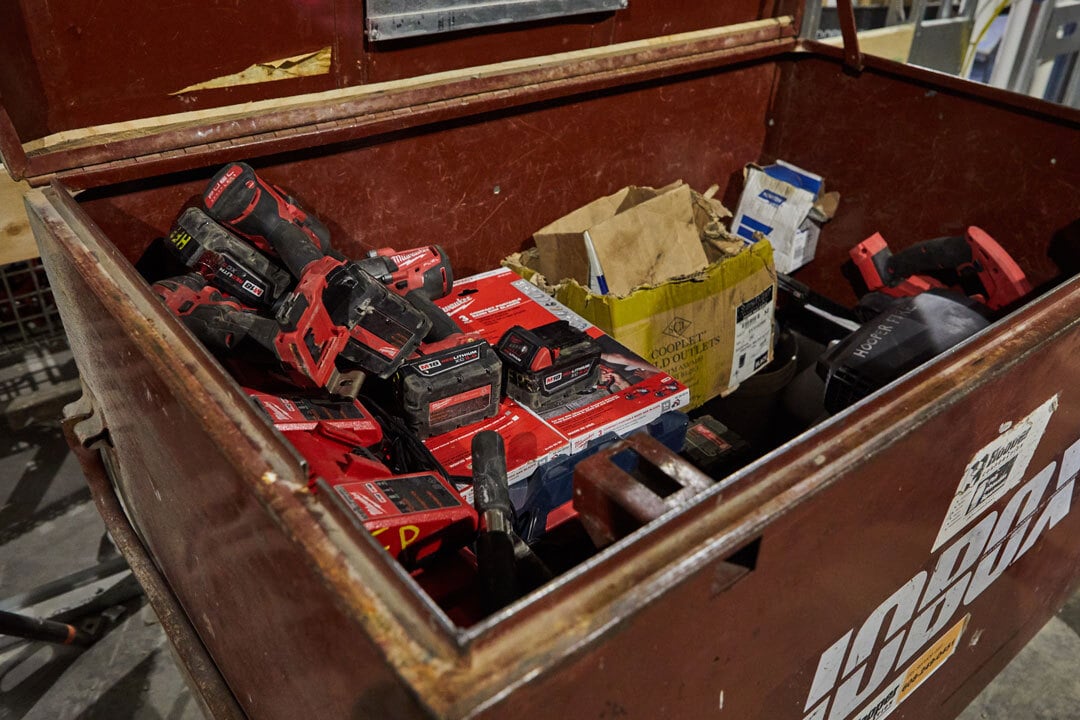
- Smoother workflows greater visibility: It’s a way to further connect the back office to the work being done on the jobsite – itemized reports on projects enable accounting teams to provide an accurate picture on how these project costs impact the overall financial health of the company.
- Smarter decisions backed by project data: Even if you never intend on doing cost reimbursement, this practice can help you better understand your company’s operations and lead to more data-informed decision making:
- Job costing decouples equipment from other fixed-overhead and gives visibility to operational costs beyond labor and materials.
- Job costing maintains efficiency and can preserve profit margins by allowing users to surface excess costs and inefficiencies in tool use. That is to say, when you have a set of tools onsite, you want to ensure they’re utilized by the field – if not, there’s an opportunity cost to having it sit idle when you could be sending it out to another job.
- Job costing maximizes the benefits of inventory management – allows a temperature check for how tool budget is impacting gross profit margin; having this information can also allow for better planning and executions for future projects. What’s more, having a pulse on this information today can help reduce the likelihood that unexpected tool costs surface throughout a project, which can be death by 10,000 cuts in terms of project profitability.
Job Costing Examples
Successful Job costing requires detailed pricing strategies that are grounded in reality and granularity as they reflect work being completed with the most faithful representation of internal processes and capacities.
For example, calculating labor costs will look to realistically define and record all workforce expenditures, from the workers and subcontractors in the field, to any third-party vendors (e.g., upfront work contracted through a prefab shop).

Materials job costing will of course calculate your traditional raw materials, but also may seek to analyze consumables like small tools and make better use of what’s being used, where, and how to better utilize your tool inventory. Further, construction overhead may include anything from miscellaneous office expenses to the much needed generator upgrade.
Construction Job Costing in Inventory Management
One natural application of job costing is the tool room.
Just as paper-based inventory practices, rife with opportunities for mishaps, are improved when merged to the cloud, job costing, typically done on costing spreadsheets, could benefit from similar digitization.
One such job costing example applied to inventory management practices can be seen in the recent feature we released to the ONE-KEY™ app:
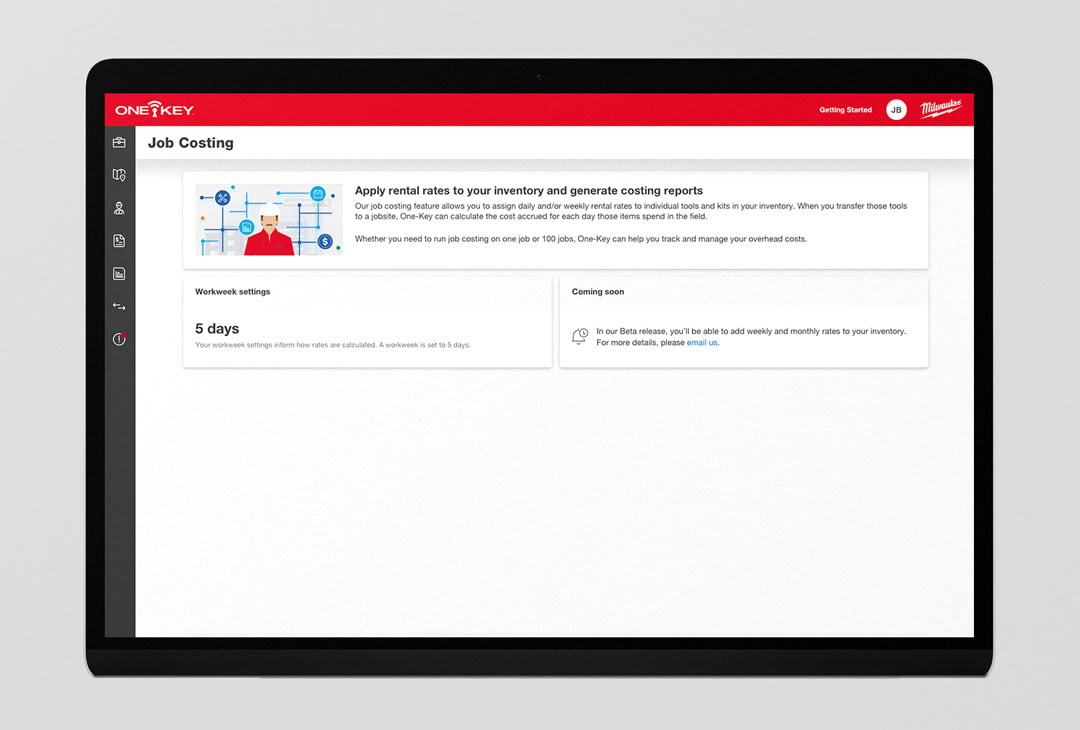
- Rate Sheets: Users can set up their own rate sheets to automatically calculate rental rates based on the rate sheet rules they set up (customizable to their needs) and the most recent tool value entered in the item detail. Users have a choice to:
-
- Set up their rate sheets from scratch manually, to directly enter model value, rates, and elect whether they’d like their rental rates to reflect daily or weekly rental rates, or both.
- Set up a smart sheet, which auto-calculates their rates for them based on dividing t tool value and how much you paid for the tool by the length of a chosen term (e.g., warranty, expected lifespan, etc.). The term is then applied to all models.
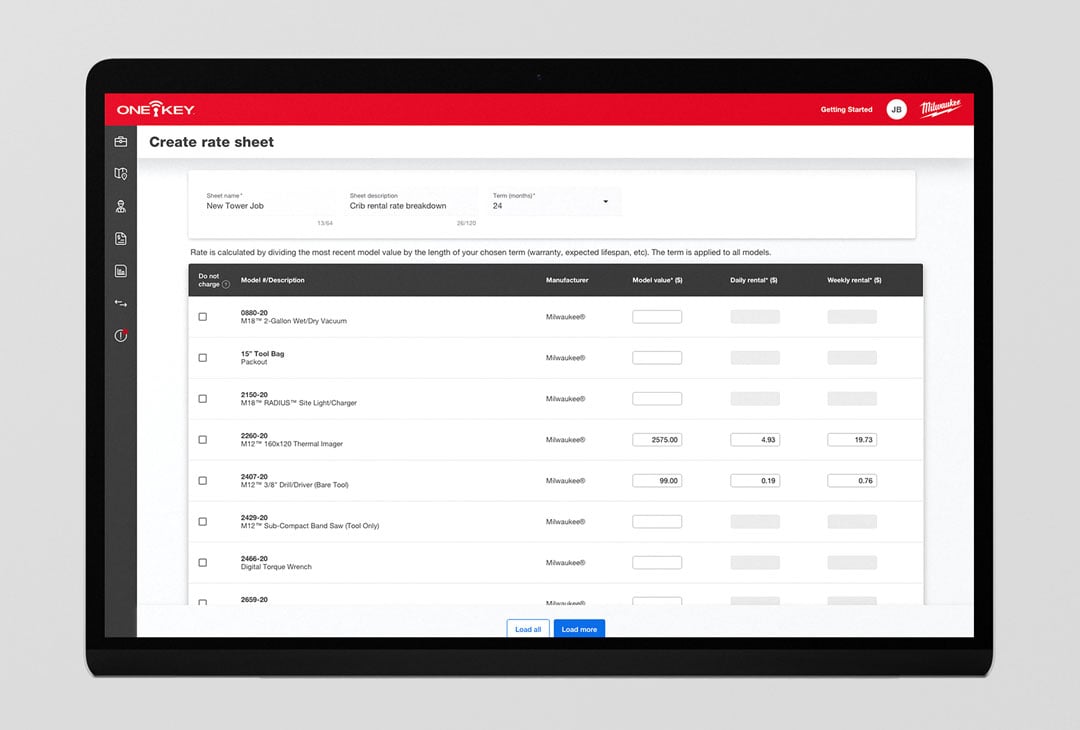
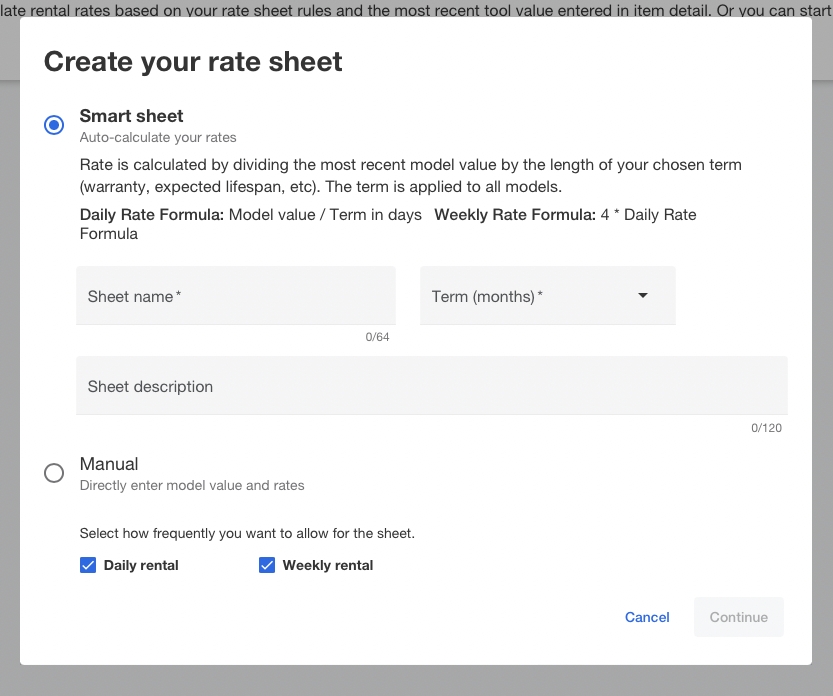
- Construction Job Cost Report: For added transparency into how these rates are calculated, users have access to fully customizable construction job costing reports that can be shared out, showing tools, rental rates per item, rental duration, etc., and formatted to include company and customer information, notations, a high-level summary, and sign off (for both a crib manager and customer). This report can be saved out as a PDF and CSV file (or both), which can be attached to an email or printed off to be signed off in person, to be uploaded to your primary system of record – which could be your ERP, project management, or account software for instance
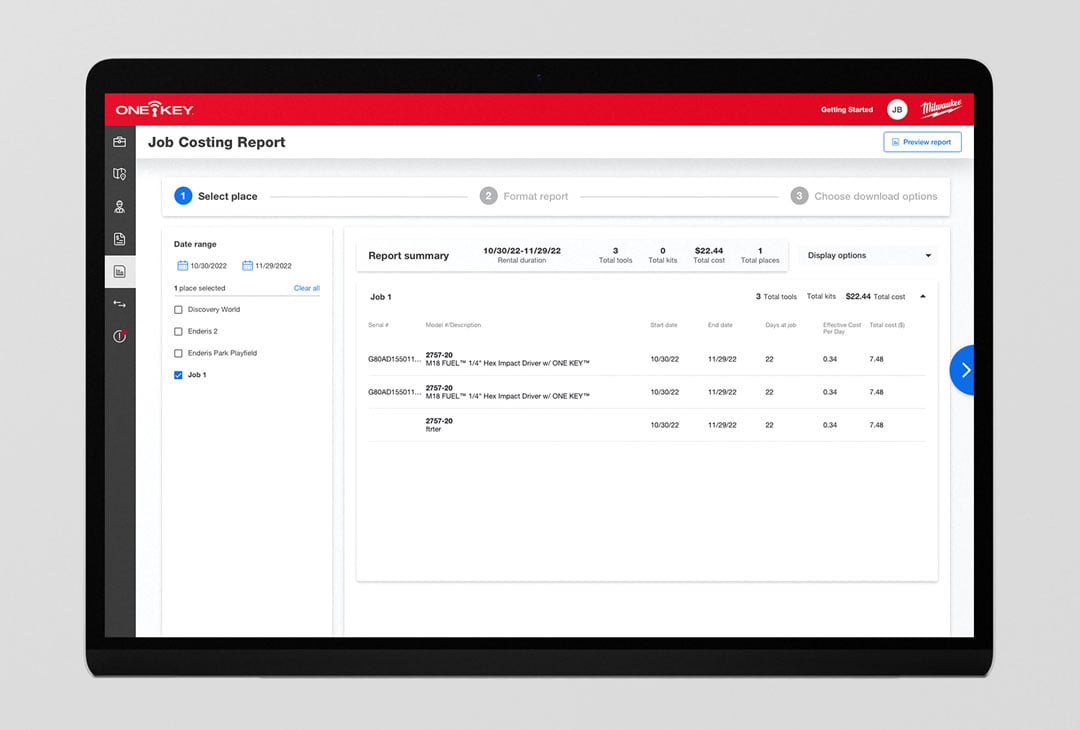
- Construction Job Cost Report History: Additionally, any reports can be elected to save to a user’s report history, which can be referenced any time you need them.
As a reminder, One-Key is a free-to-use productivity platform, and this feature is available to all users who are interested in it!
Bottom Line
Construction is an industry with razor thin profit margins (we’re talking the sub 10% range).
Labor, materials, and overhead represent the biggest expenses for the duration of a construction project.
Staying on top of tool and equipment costs is a critical part in moving the needle back toward the black. All this said, job costing is among the sharpest tools in the toolbox of the shrewdest inventory managers, leveraged to keep teams accountable and prevent tools from sitting unused.